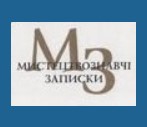СПЕЦИФІКА ЛАДОВОЇ ОРГАНІЗАЦІЇ КИТАЙСЬКОЇ МУЗИКИ НА ПРИКЛАДІ ТВОРЧОСТІ СЮЙ ЧАНЦЗЮН
SPECIFICS OF TONAL ORGANISATION OF CHINESE MUSIC ON THE EXAMPLE OF XU CHANGJUN'S WORK
Author(s): Li HuaхinSubject(s): Music, Recent History (1900 till today), Sociology of Art
Published by: Національна академія керівних кадрів культури і мистецтв
Keywords: Chinese hierarchical organisation; angemitonics; Xu Changjun; seriality;
Summary/Abstract: The purpose of the article is to highlight the specific features of the harmonic organisation of Chinese music. The task is to focus on the music of the twentieth century, the music that has been called the "New Wave" in Chinese musical culture. The latter is justified by the fact that this period is characterised by increased activity in the piano sphere and is aimed at the contamination of Western European and national Chinese styles. The research methodology is based on the use of an integrated approach, namely a system of historical comparative and typological, ethno-organological, and interdisciplinary research methods. The research material is the works of Xu Changjun. The novelty of the research lies in the fact that for the first time an attempt was made to trace the influence of the specifics of national instruments on the texture, harmonic organisation, and harmonic language. The angemitonic structures of Chinese modes are considered in the context of serial technique. A number of works by Xu Changjun, as a representative of the “New Wave”, are analysed in the context of the specifics of the harmonic organisation. Conclusions. The conclusions of the study emphasise that Xu Changjun, as a full-fledged representative of the "New Wave", uses in his music the characteristic for this trend orientation towards the ideals of the past, towards the culture of Ancient China. The harmonic side of his music is based on the Chinese system of modal modes (anhemitonic, hexatonic, heptatonic), as well as on more ancient fourstep and three-step anhemitonic structures (Chu-mode, pipa-chord) and new modality (composed by the composer). He uses both harmonic modulations and dissonant polyladic structures. His works demonstrate various types of harmonic organisation: from the modes of the yun-gong-diao system to the phenomena of new modality.
Journal: Мистецтвознавчі записки
- Issue Year: 2023
- Issue No: 43
- Page Range: 175-180
- Page Count: 6
- Language: Ukrainian

